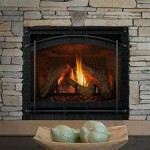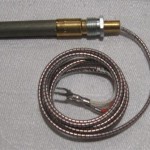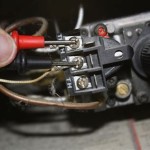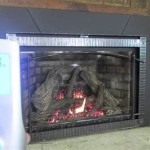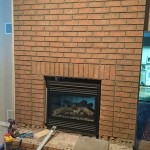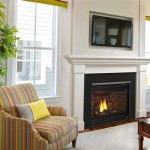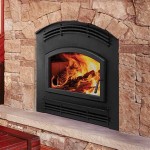River Rock Fireplace Design: A Natural Focal Point
River rock fireplaces offer a unique and visually appealing way to bring the outdoors inside. They provide a textural contrast to the smooth surfaces often found in modern homes, while simultaneously evoking a sense of warmth and natural beauty. The construction and design of a river rock fireplace require careful planning and skilled execution to ensure both aesthetic appeal and functional safety.
The allure of a river rock fireplace stems from its inherent connection to nature. These stones, rounded and smoothed by the relentless action of water, each possess unique colors, patterns, and shapes. This individuality contributes to the fireplace's distinctive character, making it a focal point that commands attention and adds a layer of organic complexity to any room.
Considerations Before Construction
Before embarking on a river rock fireplace project, several crucial factors must be addressed. These considerations encompass structural requirements, design choices, stone selection, and safety regulations. Ignoring these preliminary aspects can lead to costly mistakes or even hazardous situations.
Firstly, the existing structure must be evaluated to determine its ability to support the weight of the river rock. River rock, particularly when applied liberally, can add significant load to the floor and foundation. Consulting with a structural engineer is essential to ascertain the load-bearing capacity and identify any necessary reinforcement. This assessment will dictate the size and extent of the fireplace design.
Secondly, the design should complement the existing architectural style of the room and the overall aesthetic of the home. River rock can be incorporated into various design themes, from rustic and traditional to modern and contemporary. The key is to achieve a harmonious balance between the natural texture of the stone and the surrounding decor. Consider the scale of the fireplace in relation to the room size. An oversized fireplace in a small room can feel overwhelming, while a diminutive fireplace in a large room may appear insignificant.
Thirdly, the selection of river rock is paramount. The size, color, and shape of the stones will significantly impact the overall look and feel of the fireplace. Smaller stones tend to create a more uniform and refined appearance, while larger stones provide a bolder and more rustic aesthetic. The color palette should be chosen to harmonize with the existing color scheme of the room. Different types of river rock are available, each with its unique characteristics. Local sources may offer cost-effective options, but it's important to ensure the quality and suitability of the stones for fireplace construction. Some stones may be more prone to cracking or discoloration when exposed to heat.
Finally, adherence to local building codes and safety regulations is non-negotiable. Fireplace construction is subject to stringent safety standards to prevent fire hazards and ensure proper ventilation. These regulations typically cover aspects such as chimney height, flue size, clearance requirements from combustible materials, and the type of firebox that can be used. Obtaining the necessary permits and inspections is crucial to ensure compliance and avoid potential legal issues.
Design Elements and Style Variations
River rock fireplaces offer a versatile canvas for creative design. The arrangement of the stones, the addition of complementary materials, and the overall shape of the fireplace can all contribute to a unique and personalized aesthetic. The style variations are numerous, allowing homeowners to tailor the design to their specific preferences.
One popular style is the stacked stone fireplace, where the river rocks are arranged in horizontal layers to create a visually striking effect. This approach works well with both large and small stones and can be customized by varying the spacing between the layers. The use of different colors and sizes of stones can add depth and dimension to the design.
Another option is the dry-stacked fireplace, where the stones are arranged without mortar, creating a more natural and rustic appearance. This technique requires careful selection and precise placement of the stones to ensure stability. Dry-stacked fireplaces often incorporate larger, more irregular stones to emphasize the natural texture and shape of the material.
For a more modern aesthetic, river rock can be combined with other materials such as concrete, metal, or glass. A concrete surround with river rock accents can create a sleek and contemporary look. Integrating a metal firebox or a glass fire screen can add a touch of sophistication and modernity to the design.
The shape of the fireplace itself can also contribute to its overall style. A traditional rectangular fireplace is a classic choice, while a curved or arched fireplace can add a touch of elegance and uniqueness. Consider extending the river rock facade beyond the firebox to create a larger and more dramatic focal point. Shelves or built-in storage can also be incorporated into the design to enhance functionality and visual appeal.
Furthermore, the type of firebox used will influence the design. Wood-burning fireplaces offer a traditional and authentic experience, while gas fireplaces provide convenience and ease of use. Electric fireplaces offer a clean and modern alternative with adjustable heat settings and realistic flame effects. The choice of firebox should be based on individual preferences and lifestyle considerations.
Construction Techniques and Materials
The construction of a river rock fireplace requires specialized skills and knowledge. Proper techniques and materials are essential to ensure the structural integrity, safety, and longevity of the fireplace. The process typically involves building a solid foundation, installing a firebox and chimney, and applying the river rock veneer.
The foundation must be strong and stable enough to support the weight of the fireplace. This usually involves pouring a concrete slab that is reinforced with steel rebar. The size and thickness of the slab will depend on the size and design of the fireplace. Ensuring the foundation is level and properly cured is crucial before proceeding with the construction.
The firebox is the heart of the fireplace and must be installed according to manufacturer's instructions and local building codes. Fireboxes are typically made of metal or firebrick and are designed to contain the fire and protect the surrounding structure from heat damage. The chimney is responsible for venting the smoke and gases produced by the fire. It must be properly sized and constructed to ensure adequate draft and prevent backdrafting.
The river rock veneer is typically applied using a mortar mix that is specifically formulated for stone veneer applications. The mortar should be applied evenly to the back of each stone and pressed firmly against the firebox or substrate. Spacers can be used to maintain consistent spacing between the stones. The mortar joints should be filled and smoothed to create a seamless and visually appealing finish. The type of mortar used will depend on the type of stone and the desired aesthetic. Some mortars are designed to be visible, while others are intended to be hidden.
Grouting is a crucial step in the construction process. After the mortar has cured, the grout lines are filled to prevent water penetration and enhance the overall appearance of the fireplace. The grout should be carefully applied and cleaned to avoid staining the stones. Different grout colors can be used to create different effects. A darker grout can accentuate the texture of the stones, while a lighter grout can create a more subtle and uniform look.
Safety considerations are paramount throughout the construction process. Protective gear such as gloves, goggles, and dust masks should be worn to prevent injuries and exposure to harmful materials. Proper ventilation is essential when working with mortar and grout. Fire-resistant materials should be used in the construction of the firebox and chimney. Regular inspections should be conducted to ensure that the fireplace is being built according to code and that all safety standards are being met.

River Rock Fireplaces S Décor Five Important Decisions In Designing A Stone Fireplace Designs Veneer

Designing Luxurious Stone Fireplaces With A Treasure River Rock Selexstone Selex

Standout River Rock Fireplaces Cottage Cuties

River Rock Fireplace Photos Ideas Houzz

Add River Rock To Your List Of Fireplace Design Ideas You Ll Be Glad Did Stone Selexstone Selex

Standout River Rock Fireplace Designs All Time Favorites

Working With The River Rock Paint Built In S Grey Love This Book Shelves Fireplaces Family Room Remodel Home Fireplace

River Rock Muskoka Stone Fireplace And Oversized Flagstone Hearth From Stonecontact Com

River Rock Fireplace Photos Ideas Houzz

Standout River Rock Fireplace Designs All Time Favorites
Related Posts

